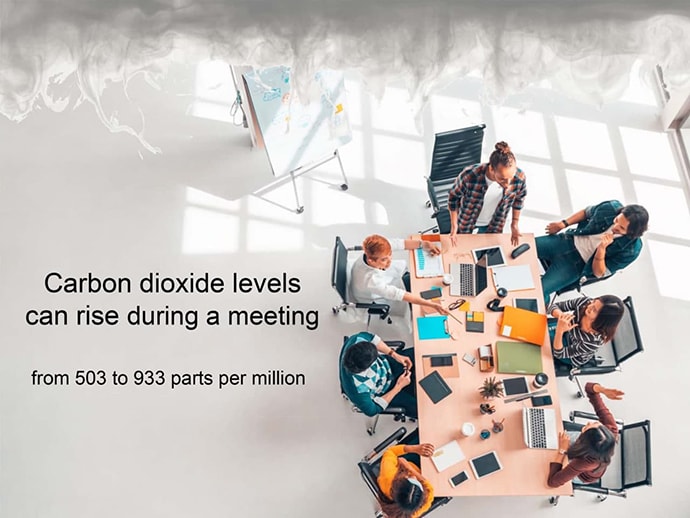|
|
|
In the aftermath of the COVID-19 pandemic, scientists say it’s time to rate indoor air quality and clean it to prevent the spread of airborne illnesses. |
Health workers already know that indoor air quality can be as important to human health as clean water and uncontaminated food. But before the COVID-19 pandemic, its importance in the prevention of respiratory illnesses outside of health circles was only whispered about.
Now, a team of nearly 40 scientists from 14 countries is calling for “a paradigm shift,” so that improvements in indoor air quality are viewed as essential to curb respiratory infections.
Most countries do not have indoor air-quality standards, the scientists point out in their recent report, and those that do often fall short in scope and enforcement.
“We expect everywhere in the world to have clean water flowing from our taps. In most parts of the developed world, it is happening and we take it completely for granted,” says lead investigator Lidia Morawska, PhD, from the International Laboratory for Air Quality and Health at the Queensland University of Technology in Brisbane, Australia.
But bacteria and viruses can circulate freely in the air, and “no one thinks about this, whatsoever, apart from healthcare facilities,” she says.
A first step is to recognize the risk posed by airborne pathogens, something not yet universally acknowledged. The investigators also want the World Health Organization to extend its guidelines to cover airborne pathogens, and for ventilation standards to include higher airflow and filtration rates.
Germany has been at the forefront of air-quality measures, Morawska says. Years ago, she observed a monitor showing the carbon dioxide level and relative humidity in the room where she was attending a meeting. The screen was accompanied by red, yellow, and green signals to communicate risk. Such indicators are also commonly displayed in German schools so teachers know when to open the windows or adjust the ventilation.
Monitors Show Carbon Dioxide Levels
But this is not yet being done in most other countries, Morawska says. Levels of carbon dioxide are one measure of indoor air quality, but they serve as a proxy for ventilation, she points out. Although the technology is available, sensors that can test a variety of components in a building in real time are not yet affordable.
Morawska envisions a future where the air quality numbers of the places people frequent are displayed so they know the risk for airborne transmission of respiratory illnesses. And people can begin to expect clean indoor air when they enter a business, office, or entertainment space and request changes when the air quality dips and improvement is needed, she says.
It is a daunting challenge to clean indoor air for several reasons. Air is not containable in the same way water is, which makes it difficult to trace contaminants. And infections transmitted through dirty water and food are usually evident immediately, whereas infections transmitted through airborne pathogens can take days to develop. Plus, the necessary infrastructure changes will be expensive.
However, the initial cost required to change the flow and quality of indoor air might be less than the cost of infections, the scientists point out. It is estimated that the global harm caused by COVID-19 alone costs $1 trillion each month.
“In the United States, the yearly cost — direct and indirect — of influenza has been calculated at $11.2 billion. For respiratory infections other than influenza, the yearly cost stood at $40 billion,” the team notes.
“If even half of this was caused by inhalation, we are still talking about massive costs,” says Morawska.
Bigger Is Not Always Better

Ehsan Mousavi
It is tempting to see the solution as increased ventilation, says Ehsan Mousavi, PhD, assistant professor of construction science and management at Clemson University in South Carolina, who studies indoor air quality and ventilation in hospitals.
“We are ventilating the heck out of hospitals,” he tells Medscape Medical News. But there is much debate about how much ventilation is the right amount. Too much and “you can blow pathogens into an open wound,” he explains. “Bigger is not always better.”
And there is still debate about the best mix of outside and recirculated air. An increase in the intake of outdoor air can refresh indoor air if it is clean, but that depends on where you live, he points out.
The mix used in most standard office buildings is 15% outside air and 85% recirculated air, Mousavi says. Boosting the percentage of outside air increases costs and energy use.
In fact, it can take five times more energy to ventilate hospital spaces than office spaces, he reports.
Engineers searching for clean-air solutions need to know what particulates are in the air and whether they are harmful to humans, but the sensors currently available can’t identify whether a virus is present in real time.
Samples have to be taken to a lab and, “by the time you know a virus was in the space, the moment is gone,” Mousavi explains.
More research is needed. “We need a reasonable answer that looks at the problem holistically, not just from the infectious disease perspective,” he says.
Hydrating Indoor Air
Research is making it clear that healthcare environments can play a significant role in patient recovery, according to Stephanie Taylor, MD, M Arch, who graduated from Harvard Medical School. After she earned her master’s degree in architecture and engineering in 2005, she founded Building4Health to help businesses assess the quality of air in their buildings and find solutions. The company uses an algorithm to arrive at a health assessment score.
Air hydration is the most important aspect to target, she says.
Since the 1980s, research has shown that a relative humidity of 40% to 60% is healthy for humans, she says. Currently, in an office building in a winter climate, the humidity level is more like 20%.
Canada is the first country to officially recommend the 40% to 60% range for senior citizen centers and residential homes.
“Properly hydrated air supports our immune system and prevents skin problem and respiratory problems. It also inactivates many bacteria and viruses,” Taylor explains. Inhaling dry air compromises the ability of the body to restrict influenza virus infection, researchers showed in a 2019 study.
In the case of COVID-19, as virus particles attach to water molecules, they get bigger and heavier and eventually drop out of the breathing zone and onto surfaces where they can be wiped away, she explains.
But when the particles “are very small — like 5 microns in diameter — and you inhale them, they can lodge deep in the lungs,” she says.
In properly hydrated air, particles will be larger — about 10 to 20 microns when they attach to the water vapor — so they will get stuck in the nose or the back of the throat, where they can be washed away by mucous and not travel to the lungs.
“Indoor air metrics” can support our health or contribute to disease, “not just over time, but quickly, within minutes or hours,” she says.
No one expects the world’s building stock to suddenly upgrade to the ideal air quality. “But that doesn’t mean we shouldn’t move in that direction,” Taylor says. Changes can start small and gradually increase.
New Research Targets Indoor Air
Humidity is one of the key areas for current research, says Karl Rockne, PhD, director of the environmental engineering program at the National Science Foundation.
“When a virus comes out, it’s not just a naked virus, which is exceptionally small. It’s a virus encapsulated in liquid. And that’s why the humidity is so key. The degree of humidity can determine how fast the water evaporates from the particle,” he tells Medscape Medical News.
In the wake of COVID-19, his institution is funding more cross-disciplinary research in biology, building science, architecture, and physics, he points out.
One such effort involved the development of a sensor that can capture live COVID-19 virus. This so-called “smoking gun,” which proved that the virus can spread through the air, took the combined expertise of professionals in medicine, engineering, and several other disciplines.
Currently, investigators are examining indoor air quality and water supplies in offices that have been left empty during the pandemic, and the effect they will have on human health. And others are looking at the way outside air quality affects indoor air quality, particularly where outdoor air quality is poor, such as in areas experiencing wildfires.
So will COVID be the catalyst that finally drives changes to building design, regulation, and public expectations of air quality in the spaces we spend close to 90% of our time?
“If not COVID, what else? It affected every country, every sector,” Morawska says. “There’s enough momentum now to do something about this. And enough realization there is a problem.”
Marcia Frellick is a freelance journalist based in Chicago. She has previously written for the Chicago Tribune, Science News, and Nurse.com, and was an editor at the Chicago Sun-Times, the Cincinnati Enquirer, and the St. Cloud (Minnesota) Times. Follow her on Twitter at @mfrellick. Follow Medscape on Facebook, Twitter, Instagram, and YouTube.
Source: Read Full Article
